China's Public Management: Analyzing CSR Reporting Public Reform
VerifiedAdded on 2021/05/10
|8
|4087
|290
Essay
AI Summary
This essay examines the public reform of Corporate Social Responsibility (CSR) reporting in China, focusing on its implementation and impact on public management. The research question explores whether the public reform in CSR reporting has been successfully implemented in China, considering the country's unique social, political, and environmental context. The literature review analyzes different perspectives on CSR in China, including positive, negative, and no correlation between CSR and value creation. The essay also formulates a hypothesis based on stakeholder theory, legitimacy theory, and social contract perspective, suggesting that companies taking a social contract perspective in operation will generate positive value creation when integrating CSR in business. It also discusses potential agency problems and bureaucratic structures that may hinder the successful integration of CSR. Desklib provides students with access to similar essays and study tools to enhance their understanding of CSR and public management.
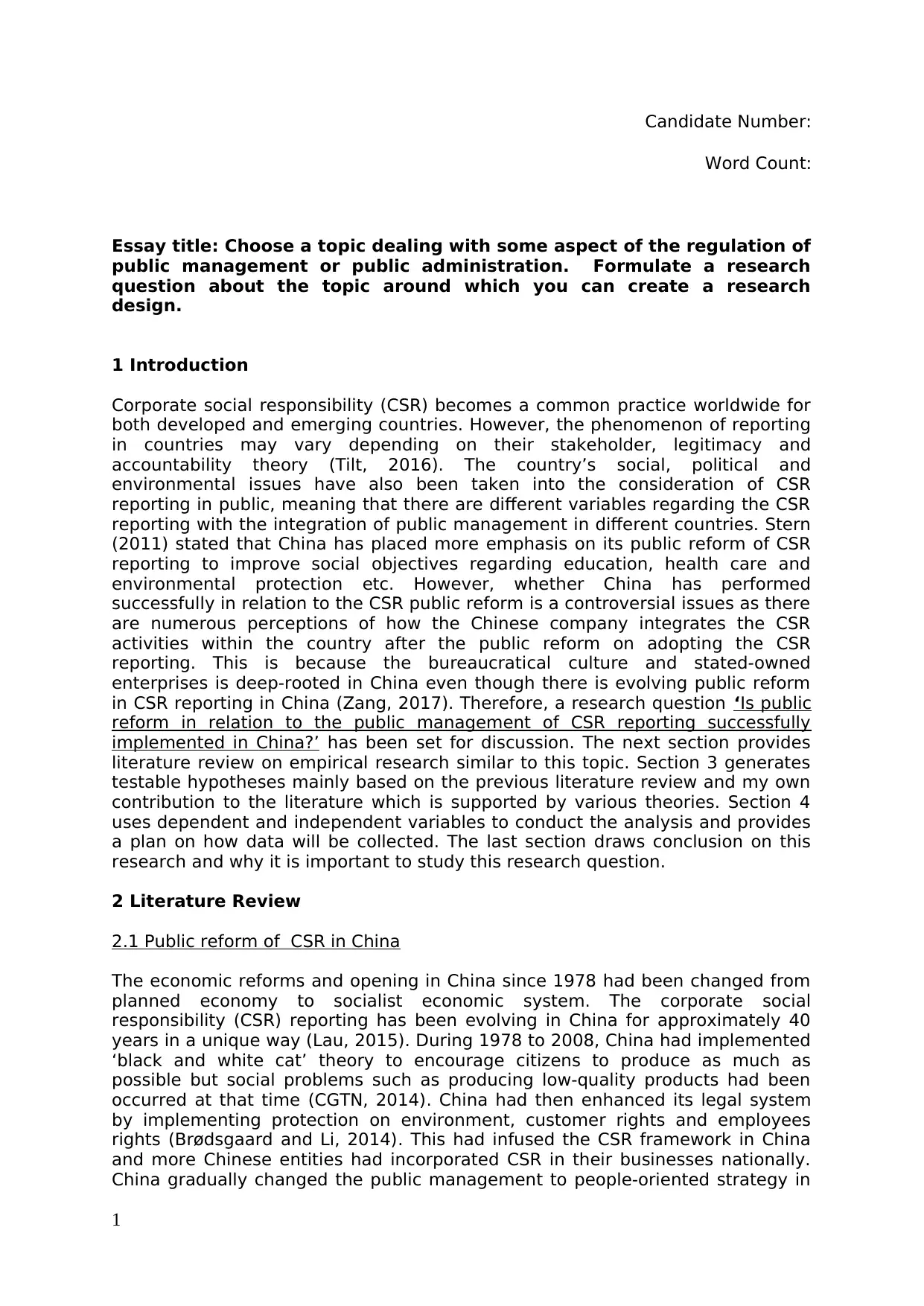
Candidate Number:
Word Count:
Essay title: Choose a topic dealing with some aspect of the regulation of
public management or public administration. Formulate a research
question about the topic around which you can create a research
design.
1 Introduction
Corporate social responsibility (CSR) becomes a common practice worldwide for
both developed and emerging countries. However, the phenomenon of reporting
in countries may vary depending on their stakeholder, legitimacy and
accountability theory (Tilt, 2016). The country’s social, political and
environmental issues have also been taken into the consideration of CSR
reporting in public, meaning that there are different variables regarding the CSR
reporting with the integration of public management in different countries. Stern
(2011) stated that China has placed more emphasis on its public reform of CSR
reporting to improve social objectives regarding education, health care and
environmental protection etc. However, whether China has performed
successfully in relation to the CSR public reform is a controversial issues as there
are numerous perceptions of how the Chinese company integrates the CSR
activities within the country after the public reform on adopting the CSR
reporting. This is because the bureaucratical culture and stated-owned
enterprises is deep-rooted in China even though there is evolving public reform
in CSR reporting in China (Zang, 2017). Therefore, a research question ‘Is public
reform in relation to the public management of CSR reporting successfully
implemented in China?’ has been set for discussion. The next section provides
literature review on empirical research similar to this topic. Section 3 generates
testable hypotheses mainly based on the previous literature review and my own
contribution to the literature which is supported by various theories. Section 4
uses dependent and independent variables to conduct the analysis and provides
a plan on how data will be collected. The last section draws conclusion on this
research and why it is important to study this research question.
2 Literature Review
2.1 Public reform of CSR in China
The economic reforms and opening in China since 1978 had been changed from
planned economy to socialist economic system. The corporate social
responsibility (CSR) reporting has been evolving in China for approximately 40
years in a unique way (Lau, 2015). During 1978 to 2008, China had implemented
‘black and white cat’ theory to encourage citizens to produce as much as
possible but social problems such as producing low-quality products had been
occurred at that time (CGTN, 2014). China had then enhanced its legal system
by implementing protection on environment, customer rights and employees
rights (Brødsgaard and Li, 2014). This had infused the CSR framework in China
and more Chinese entities had incorporated CSR in their businesses nationally.
China gradually changed the public management to people-oriented strategy in
1
Word Count:
Essay title: Choose a topic dealing with some aspect of the regulation of
public management or public administration. Formulate a research
question about the topic around which you can create a research
design.
1 Introduction
Corporate social responsibility (CSR) becomes a common practice worldwide for
both developed and emerging countries. However, the phenomenon of reporting
in countries may vary depending on their stakeholder, legitimacy and
accountability theory (Tilt, 2016). The country’s social, political and
environmental issues have also been taken into the consideration of CSR
reporting in public, meaning that there are different variables regarding the CSR
reporting with the integration of public management in different countries. Stern
(2011) stated that China has placed more emphasis on its public reform of CSR
reporting to improve social objectives regarding education, health care and
environmental protection etc. However, whether China has performed
successfully in relation to the CSR public reform is a controversial issues as there
are numerous perceptions of how the Chinese company integrates the CSR
activities within the country after the public reform on adopting the CSR
reporting. This is because the bureaucratical culture and stated-owned
enterprises is deep-rooted in China even though there is evolving public reform
in CSR reporting in China (Zang, 2017). Therefore, a research question ‘Is public
reform in relation to the public management of CSR reporting successfully
implemented in China?’ has been set for discussion. The next section provides
literature review on empirical research similar to this topic. Section 3 generates
testable hypotheses mainly based on the previous literature review and my own
contribution to the literature which is supported by various theories. Section 4
uses dependent and independent variables to conduct the analysis and provides
a plan on how data will be collected. The last section draws conclusion on this
research and why it is important to study this research question.
2 Literature Review
2.1 Public reform of CSR in China
The economic reforms and opening in China since 1978 had been changed from
planned economy to socialist economic system. The corporate social
responsibility (CSR) reporting has been evolving in China for approximately 40
years in a unique way (Lau, 2015). During 1978 to 2008, China had implemented
‘black and white cat’ theory to encourage citizens to produce as much as
possible but social problems such as producing low-quality products had been
occurred at that time (CGTN, 2014). China had then enhanced its legal system
by implementing protection on environment, customer rights and employees
rights (Brødsgaard and Li, 2014). This had infused the CSR framework in China
and more Chinese entities had incorporated CSR in their businesses nationally.
China gradually changed the public management to people-oriented strategy in
1
Paraphrase This Document
Need a fresh take? Get an instant paraphrase of this document with our AI Paraphraser
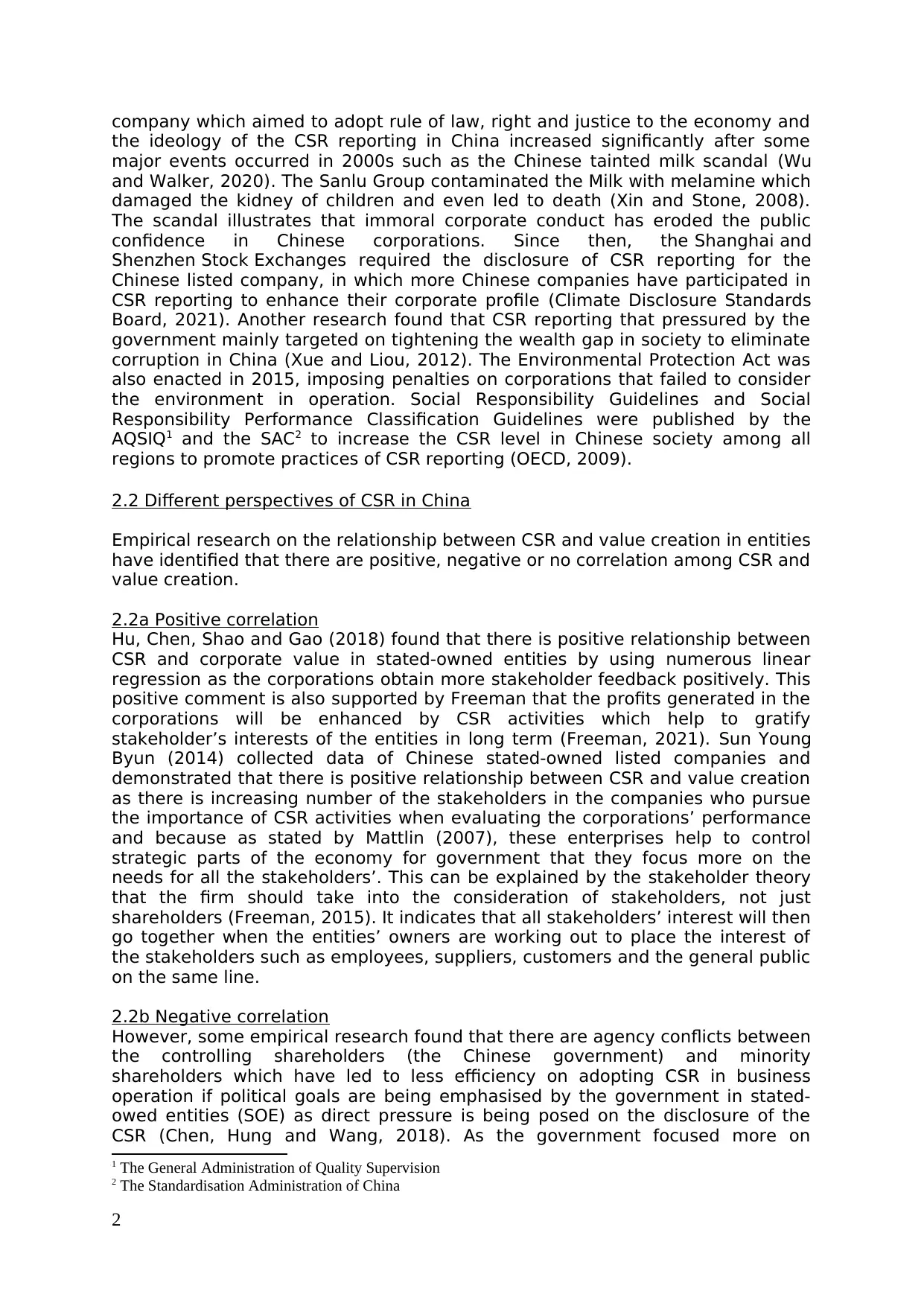
company which aimed to adopt rule of law, right and justice to the economy and
the ideology of the CSR reporting in China increased significantly after some
major events occurred in 2000s such as the Chinese tainted milk scandal (Wu
and Walker, 2020). The Sanlu Group contaminated the Milk with melamine which
damaged the kidney of children and even led to death (Xin and Stone, 2008).
The scandal illustrates that immoral corporate conduct has eroded the public
confidence in Chinese corporations. Since then, the Shanghai and
Shenzhen Stock Exchanges required the disclosure of CSR reporting for the
Chinese listed company, in which more Chinese companies have participated in
CSR reporting to enhance their corporate profile (Climate Disclosure Standards
Board, 2021). Another research found that CSR reporting that pressured by the
government mainly targeted on tightening the wealth gap in society to eliminate
corruption in China (Xue and Liou, 2012). The Environmental Protection Act was
also enacted in 2015, imposing penalties on corporations that failed to consider
the environment in operation. Social Responsibility Guidelines and Social
Responsibility Performance Classification Guidelines were published by the
AQSIQ1 and the SAC2 to increase the CSR level in Chinese society among all
regions to promote practices of CSR reporting (OECD, 2009).
2.2 Different perspectives of CSR in China
Empirical research on the relationship between CSR and value creation in entities
have identified that there are positive, negative or no correlation among CSR and
value creation.
2.2a Positive correlation
Hu, Chen, Shao and Gao (2018) found that there is positive relationship between
CSR and corporate value in stated-owned entities by using numerous linear
regression as the corporations obtain more stakeholder feedback positively. This
positive comment is also supported by Freeman that the profits generated in the
corporations will be enhanced by CSR activities which help to gratify
stakeholder’s interests of the entities in long term (Freeman, 2021). Sun Young
Byun (2014) collected data of Chinese stated-owned listed companies and
demonstrated that there is positive relationship between CSR and value creation
as there is increasing number of the stakeholders in the companies who pursue
the importance of CSR activities when evaluating the corporations’ performance
and because as stated by Mattlin (2007), these enterprises help to control
strategic parts of the economy for government that they focus more on the
needs for all the stakeholders’. This can be explained by the stakeholder theory
that the firm should take into the consideration of stakeholders, not just
shareholders (Freeman, 2015). It indicates that all stakeholders’ interest will then
go together when the entities’ owners are working out to place the interest of
the stakeholders such as employees, suppliers, customers and the general public
on the same line.
2.2b Negative correlation
However, some empirical research found that there are agency conflicts between
the controlling shareholders (the Chinese government) and minority
shareholders which have led to less efficiency on adopting CSR in business
operation if political goals are being emphasised by the government in stated-
owed entities (SOE) as direct pressure is being posed on the disclosure of the
CSR (Chen, Hung and Wang, 2018). As the government focused more on
1 The General Administration of Quality Supervision
2 The Standardisation Administration of China
2
the ideology of the CSR reporting in China increased significantly after some
major events occurred in 2000s such as the Chinese tainted milk scandal (Wu
and Walker, 2020). The Sanlu Group contaminated the Milk with melamine which
damaged the kidney of children and even led to death (Xin and Stone, 2008).
The scandal illustrates that immoral corporate conduct has eroded the public
confidence in Chinese corporations. Since then, the Shanghai and
Shenzhen Stock Exchanges required the disclosure of CSR reporting for the
Chinese listed company, in which more Chinese companies have participated in
CSR reporting to enhance their corporate profile (Climate Disclosure Standards
Board, 2021). Another research found that CSR reporting that pressured by the
government mainly targeted on tightening the wealth gap in society to eliminate
corruption in China (Xue and Liou, 2012). The Environmental Protection Act was
also enacted in 2015, imposing penalties on corporations that failed to consider
the environment in operation. Social Responsibility Guidelines and Social
Responsibility Performance Classification Guidelines were published by the
AQSIQ1 and the SAC2 to increase the CSR level in Chinese society among all
regions to promote practices of CSR reporting (OECD, 2009).
2.2 Different perspectives of CSR in China
Empirical research on the relationship between CSR and value creation in entities
have identified that there are positive, negative or no correlation among CSR and
value creation.
2.2a Positive correlation
Hu, Chen, Shao and Gao (2018) found that there is positive relationship between
CSR and corporate value in stated-owned entities by using numerous linear
regression as the corporations obtain more stakeholder feedback positively. This
positive comment is also supported by Freeman that the profits generated in the
corporations will be enhanced by CSR activities which help to gratify
stakeholder’s interests of the entities in long term (Freeman, 2021). Sun Young
Byun (2014) collected data of Chinese stated-owned listed companies and
demonstrated that there is positive relationship between CSR and value creation
as there is increasing number of the stakeholders in the companies who pursue
the importance of CSR activities when evaluating the corporations’ performance
and because as stated by Mattlin (2007), these enterprises help to control
strategic parts of the economy for government that they focus more on the
needs for all the stakeholders’. This can be explained by the stakeholder theory
that the firm should take into the consideration of stakeholders, not just
shareholders (Freeman, 2015). It indicates that all stakeholders’ interest will then
go together when the entities’ owners are working out to place the interest of
the stakeholders such as employees, suppliers, customers and the general public
on the same line.
2.2b Negative correlation
However, some empirical research found that there are agency conflicts between
the controlling shareholders (the Chinese government) and minority
shareholders which have led to less efficiency on adopting CSR in business
operation if political goals are being emphasised by the government in stated-
owed entities (SOE) as direct pressure is being posed on the disclosure of the
CSR (Chen, Hung and Wang, 2018). As the government focused more on
1 The General Administration of Quality Supervision
2 The Standardisation Administration of China
2
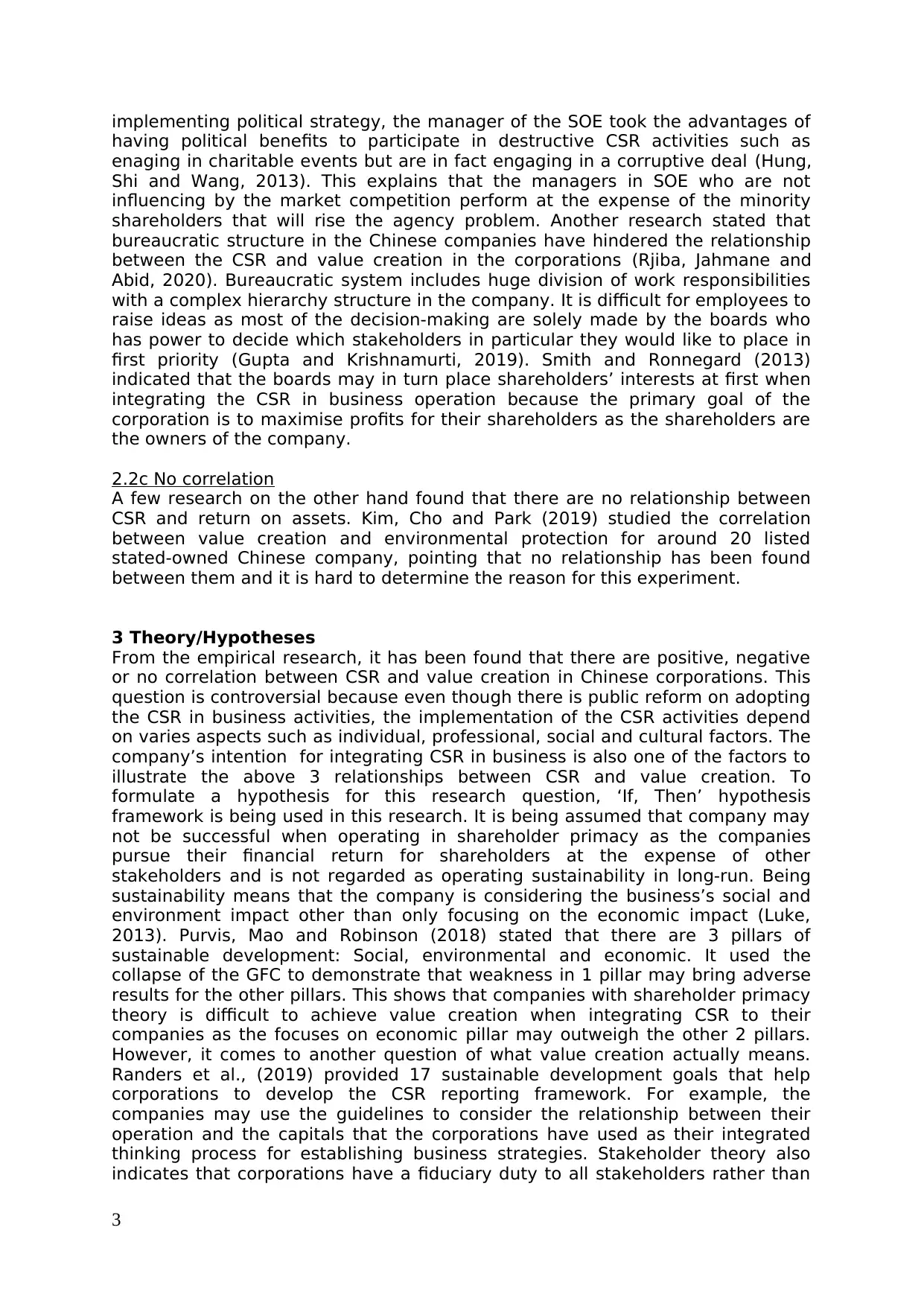
implementing political strategy, the manager of the SOE took the advantages of
having political benefits to participate in destructive CSR activities such as
enaging in charitable events but are in fact engaging in a corruptive deal (Hung,
Shi and Wang, 2013). This explains that the managers in SOE who are not
influencing by the market competition perform at the expense of the minority
shareholders that will rise the agency problem. Another research stated that
bureaucratic structure in the Chinese companies have hindered the relationship
between the CSR and value creation in the corporations (Rjiba, Jahmane and
Abid, 2020). Bureaucratic system includes huge division of work responsibilities
with a complex hierarchy structure in the company. It is difficult for employees to
raise ideas as most of the decision-making are solely made by the boards who
has power to decide which stakeholders in particular they would like to place in
first priority (Gupta and Krishnamurti, 2019). Smith and Ronnegard (2013)
indicated that the boards may in turn place shareholders’ interests at first when
integrating the CSR in business operation because the primary goal of the
corporation is to maximise profits for their shareholders as the shareholders are
the owners of the company.
2.2c No correlation
A few research on the other hand found that there are no relationship between
CSR and return on assets. Kim, Cho and Park (2019) studied the correlation
between value creation and environmental protection for around 20 listed
stated-owned Chinese company, pointing that no relationship has been found
between them and it is hard to determine the reason for this experiment.
3 Theory/Hypotheses
From the empirical research, it has been found that there are positive, negative
or no correlation between CSR and value creation in Chinese corporations. This
question is controversial because even though there is public reform on adopting
the CSR in business activities, the implementation of the CSR activities depend
on varies aspects such as individual, professional, social and cultural factors. The
company’s intention for integrating CSR in business is also one of the factors to
illustrate the above 3 relationships between CSR and value creation. To
formulate a hypothesis for this research question, ‘If, Then’ hypothesis
framework is being used in this research. It is being assumed that company may
not be successful when operating in shareholder primacy as the companies
pursue their financial return for shareholders at the expense of other
stakeholders and is not regarded as operating sustainability in long-run. Being
sustainability means that the company is considering the business’s social and
environment impact other than only focusing on the economic impact (Luke,
2013). Purvis, Mao and Robinson (2018) stated that there are 3 pillars of
sustainable development: Social, environmental and economic. It used the
collapse of the GFC to demonstrate that weakness in 1 pillar may bring adverse
results for the other pillars. This shows that companies with shareholder primacy
theory is difficult to achieve value creation when integrating CSR to their
companies as the focuses on economic pillar may outweigh the other 2 pillars.
However, it comes to another question of what value creation actually means.
Randers et al., (2019) provided 17 sustainable development goals that help
corporations to develop the CSR reporting framework. For example, the
companies may use the guidelines to consider the relationship between their
operation and the capitals that the corporations have used as their integrated
thinking process for establishing business strategies. Stakeholder theory also
indicates that corporations have a fiduciary duty to all stakeholders rather than
3
having political benefits to participate in destructive CSR activities such as
enaging in charitable events but are in fact engaging in a corruptive deal (Hung,
Shi and Wang, 2013). This explains that the managers in SOE who are not
influencing by the market competition perform at the expense of the minority
shareholders that will rise the agency problem. Another research stated that
bureaucratic structure in the Chinese companies have hindered the relationship
between the CSR and value creation in the corporations (Rjiba, Jahmane and
Abid, 2020). Bureaucratic system includes huge division of work responsibilities
with a complex hierarchy structure in the company. It is difficult for employees to
raise ideas as most of the decision-making are solely made by the boards who
has power to decide which stakeholders in particular they would like to place in
first priority (Gupta and Krishnamurti, 2019). Smith and Ronnegard (2013)
indicated that the boards may in turn place shareholders’ interests at first when
integrating the CSR in business operation because the primary goal of the
corporation is to maximise profits for their shareholders as the shareholders are
the owners of the company.
2.2c No correlation
A few research on the other hand found that there are no relationship between
CSR and return on assets. Kim, Cho and Park (2019) studied the correlation
between value creation and environmental protection for around 20 listed
stated-owned Chinese company, pointing that no relationship has been found
between them and it is hard to determine the reason for this experiment.
3 Theory/Hypotheses
From the empirical research, it has been found that there are positive, negative
or no correlation between CSR and value creation in Chinese corporations. This
question is controversial because even though there is public reform on adopting
the CSR in business activities, the implementation of the CSR activities depend
on varies aspects such as individual, professional, social and cultural factors. The
company’s intention for integrating CSR in business is also one of the factors to
illustrate the above 3 relationships between CSR and value creation. To
formulate a hypothesis for this research question, ‘If, Then’ hypothesis
framework is being used in this research. It is being assumed that company may
not be successful when operating in shareholder primacy as the companies
pursue their financial return for shareholders at the expense of other
stakeholders and is not regarded as operating sustainability in long-run. Being
sustainability means that the company is considering the business’s social and
environment impact other than only focusing on the economic impact (Luke,
2013). Purvis, Mao and Robinson (2018) stated that there are 3 pillars of
sustainable development: Social, environmental and economic. It used the
collapse of the GFC to demonstrate that weakness in 1 pillar may bring adverse
results for the other pillars. This shows that companies with shareholder primacy
theory is difficult to achieve value creation when integrating CSR to their
companies as the focuses on economic pillar may outweigh the other 2 pillars.
However, it comes to another question of what value creation actually means.
Randers et al., (2019) provided 17 sustainable development goals that help
corporations to develop the CSR reporting framework. For example, the
companies may use the guidelines to consider the relationship between their
operation and the capitals that the corporations have used as their integrated
thinking process for establishing business strategies. Stakeholder theory also
indicates that corporations have a fiduciary duty to all stakeholders rather than
3
⊘ This is a preview!⊘
Do you want full access?
Subscribe today to unlock all pages.

Trusted by 1+ million students worldwide
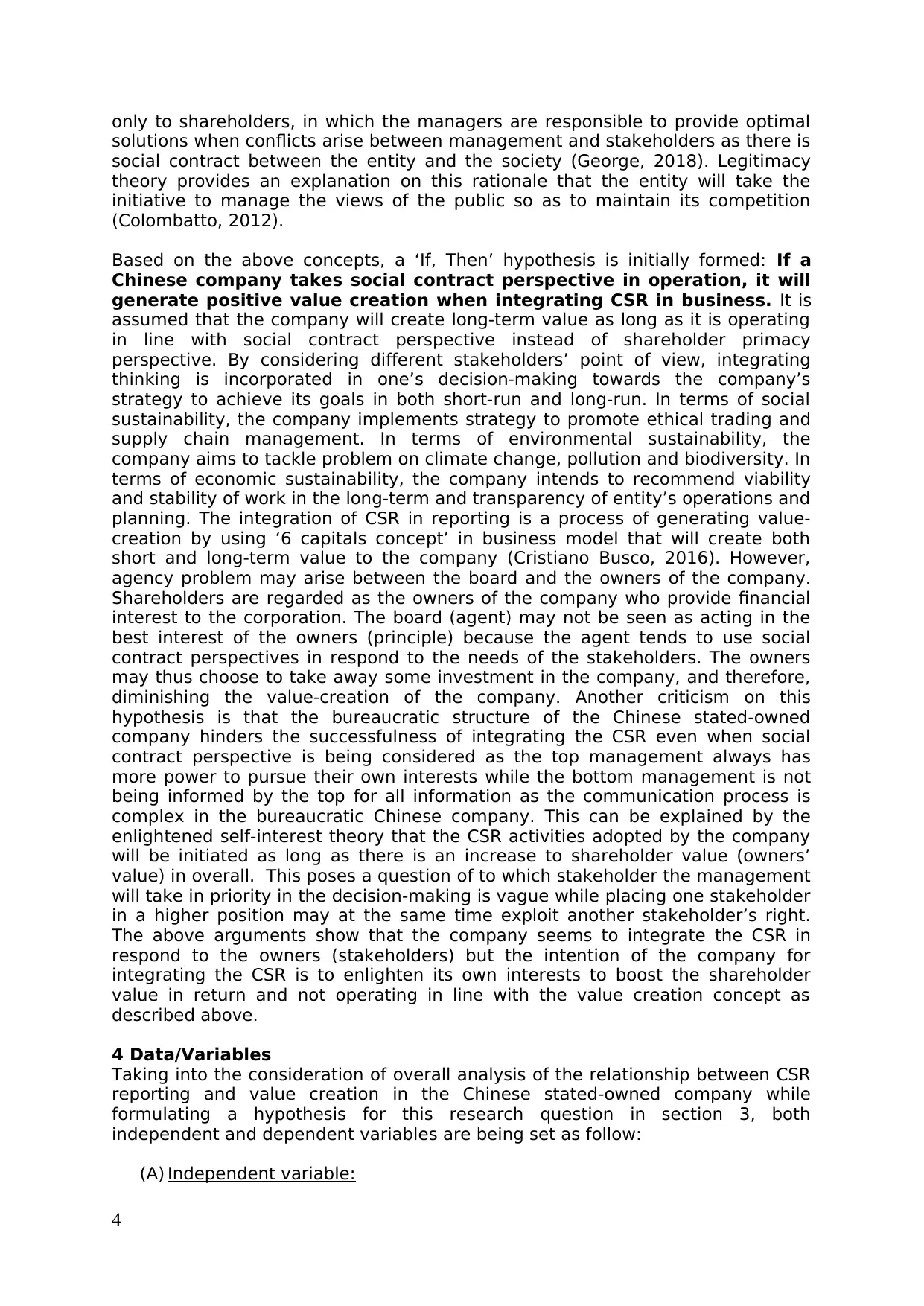
only to shareholders, in which the managers are responsible to provide optimal
solutions when conflicts arise between management and stakeholders as there is
social contract between the entity and the society (George, 2018). Legitimacy
theory provides an explanation on this rationale that the entity will take the
initiative to manage the views of the public so as to maintain its competition
(Colombatto, 2012).
Based on the above concepts, a ‘If, Then’ hypothesis is initially formed: If a
Chinese company takes social contract perspective in operation, it will
generate positive value creation when integrating CSR in business. It is
assumed that the company will create long-term value as long as it is operating
in line with social contract perspective instead of shareholder primacy
perspective. By considering different stakeholders’ point of view, integrating
thinking is incorporated in one’s decision-making towards the company’s
strategy to achieve its goals in both short-run and long-run. In terms of social
sustainability, the company implements strategy to promote ethical trading and
supply chain management. In terms of environmental sustainability, the
company aims to tackle problem on climate change, pollution and biodiversity. In
terms of economic sustainability, the company intends to recommend viability
and stability of work in the long-term and transparency of entity’s operations and
planning. The integration of CSR in reporting is a process of generating value-
creation by using ‘6 capitals concept’ in business model that will create both
short and long-term value to the company (Cristiano Busco, 2016). However,
agency problem may arise between the board and the owners of the company.
Shareholders are regarded as the owners of the company who provide financial
interest to the corporation. The board (agent) may not be seen as acting in the
best interest of the owners (principle) because the agent tends to use social
contract perspectives in respond to the needs of the stakeholders. The owners
may thus choose to take away some investment in the company, and therefore,
diminishing the value-creation of the company. Another criticism on this
hypothesis is that the bureaucratic structure of the Chinese stated-owned
company hinders the successfulness of integrating the CSR even when social
contract perspective is being considered as the top management always has
more power to pursue their own interests while the bottom management is not
being informed by the top for all information as the communication process is
complex in the bureaucratic Chinese company. This can be explained by the
enlightened self-interest theory that the CSR activities adopted by the company
will be initiated as long as there is an increase to shareholder value (owners’
value) in overall. This poses a question of to which stakeholder the management
will take in priority in the decision-making is vague while placing one stakeholder
in a higher position may at the same time exploit another stakeholder’s right.
The above arguments show that the company seems to integrate the CSR in
respond to the owners (stakeholders) but the intention of the company for
integrating the CSR is to enlighten its own interests to boost the shareholder
value in return and not operating in line with the value creation concept as
described above.
4 Data/Variables
Taking into the consideration of overall analysis of the relationship between CSR
reporting and value creation in the Chinese stated-owned company while
formulating a hypothesis for this research question in section 3, both
independent and dependent variables are being set as follow:
(A) Independent variable:
4
solutions when conflicts arise between management and stakeholders as there is
social contract between the entity and the society (George, 2018). Legitimacy
theory provides an explanation on this rationale that the entity will take the
initiative to manage the views of the public so as to maintain its competition
(Colombatto, 2012).
Based on the above concepts, a ‘If, Then’ hypothesis is initially formed: If a
Chinese company takes social contract perspective in operation, it will
generate positive value creation when integrating CSR in business. It is
assumed that the company will create long-term value as long as it is operating
in line with social contract perspective instead of shareholder primacy
perspective. By considering different stakeholders’ point of view, integrating
thinking is incorporated in one’s decision-making towards the company’s
strategy to achieve its goals in both short-run and long-run. In terms of social
sustainability, the company implements strategy to promote ethical trading and
supply chain management. In terms of environmental sustainability, the
company aims to tackle problem on climate change, pollution and biodiversity. In
terms of economic sustainability, the company intends to recommend viability
and stability of work in the long-term and transparency of entity’s operations and
planning. The integration of CSR in reporting is a process of generating value-
creation by using ‘6 capitals concept’ in business model that will create both
short and long-term value to the company (Cristiano Busco, 2016). However,
agency problem may arise between the board and the owners of the company.
Shareholders are regarded as the owners of the company who provide financial
interest to the corporation. The board (agent) may not be seen as acting in the
best interest of the owners (principle) because the agent tends to use social
contract perspectives in respond to the needs of the stakeholders. The owners
may thus choose to take away some investment in the company, and therefore,
diminishing the value-creation of the company. Another criticism on this
hypothesis is that the bureaucratic structure of the Chinese stated-owned
company hinders the successfulness of integrating the CSR even when social
contract perspective is being considered as the top management always has
more power to pursue their own interests while the bottom management is not
being informed by the top for all information as the communication process is
complex in the bureaucratic Chinese company. This can be explained by the
enlightened self-interest theory that the CSR activities adopted by the company
will be initiated as long as there is an increase to shareholder value (owners’
value) in overall. This poses a question of to which stakeholder the management
will take in priority in the decision-making is vague while placing one stakeholder
in a higher position may at the same time exploit another stakeholder’s right.
The above arguments show that the company seems to integrate the CSR in
respond to the owners (stakeholders) but the intention of the company for
integrating the CSR is to enlighten its own interests to boost the shareholder
value in return and not operating in line with the value creation concept as
described above.
4 Data/Variables
Taking into the consideration of overall analysis of the relationship between CSR
reporting and value creation in the Chinese stated-owned company while
formulating a hypothesis for this research question in section 3, both
independent and dependent variables are being set as follow:
(A) Independent variable:
4
Paraphrase This Document
Need a fresh take? Get an instant paraphrase of this document with our AI Paraphraser
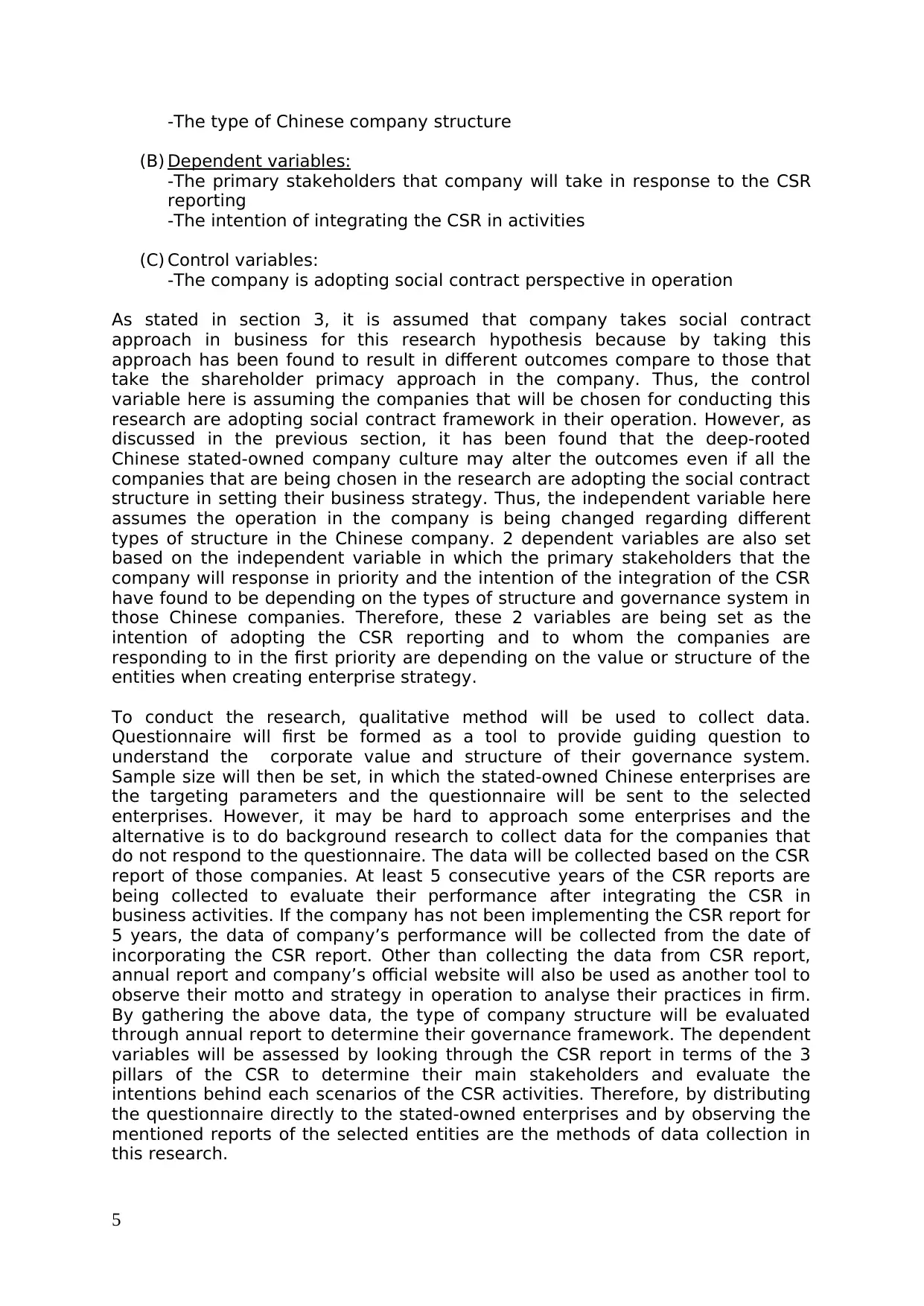
-The type of Chinese company structure
(B) Dependent variables:
-The primary stakeholders that company will take in response to the CSR
reporting
-The intention of integrating the CSR in activities
(C) Control variables:
-The company is adopting social contract perspective in operation
As stated in section 3, it is assumed that company takes social contract
approach in business for this research hypothesis because by taking this
approach has been found to result in different outcomes compare to those that
take the shareholder primacy approach in the company. Thus, the control
variable here is assuming the companies that will be chosen for conducting this
research are adopting social contract framework in their operation. However, as
discussed in the previous section, it has been found that the deep-rooted
Chinese stated-owned company culture may alter the outcomes even if all the
companies that are being chosen in the research are adopting the social contract
structure in setting their business strategy. Thus, the independent variable here
assumes the operation in the company is being changed regarding different
types of structure in the Chinese company. 2 dependent variables are also set
based on the independent variable in which the primary stakeholders that the
company will response in priority and the intention of the integration of the CSR
have found to be depending on the types of structure and governance system in
those Chinese companies. Therefore, these 2 variables are being set as the
intention of adopting the CSR reporting and to whom the companies are
responding to in the first priority are depending on the value or structure of the
entities when creating enterprise strategy.
To conduct the research, qualitative method will be used to collect data.
Questionnaire will first be formed as a tool to provide guiding question to
understand the corporate value and structure of their governance system.
Sample size will then be set, in which the stated-owned Chinese enterprises are
the targeting parameters and the questionnaire will be sent to the selected
enterprises. However, it may be hard to approach some enterprises and the
alternative is to do background research to collect data for the companies that
do not respond to the questionnaire. The data will be collected based on the CSR
report of those companies. At least 5 consecutive years of the CSR reports are
being collected to evaluate their performance after integrating the CSR in
business activities. If the company has not been implementing the CSR report for
5 years, the data of company’s performance will be collected from the date of
incorporating the CSR report. Other than collecting the data from CSR report,
annual report and company’s official website will also be used as another tool to
observe their motto and strategy in operation to analyse their practices in firm.
By gathering the above data, the type of company structure will be evaluated
through annual report to determine their governance framework. The dependent
variables will be assessed by looking through the CSR report in terms of the 3
pillars of the CSR to determine their main stakeholders and evaluate the
intentions behind each scenarios of the CSR activities. Therefore, by distributing
the questionnaire directly to the stated-owned enterprises and by observing the
mentioned reports of the selected entities are the methods of data collection in
this research.
5
(B) Dependent variables:
-The primary stakeholders that company will take in response to the CSR
reporting
-The intention of integrating the CSR in activities
(C) Control variables:
-The company is adopting social contract perspective in operation
As stated in section 3, it is assumed that company takes social contract
approach in business for this research hypothesis because by taking this
approach has been found to result in different outcomes compare to those that
take the shareholder primacy approach in the company. Thus, the control
variable here is assuming the companies that will be chosen for conducting this
research are adopting social contract framework in their operation. However, as
discussed in the previous section, it has been found that the deep-rooted
Chinese stated-owned company culture may alter the outcomes even if all the
companies that are being chosen in the research are adopting the social contract
structure in setting their business strategy. Thus, the independent variable here
assumes the operation in the company is being changed regarding different
types of structure in the Chinese company. 2 dependent variables are also set
based on the independent variable in which the primary stakeholders that the
company will response in priority and the intention of the integration of the CSR
have found to be depending on the types of structure and governance system in
those Chinese companies. Therefore, these 2 variables are being set as the
intention of adopting the CSR reporting and to whom the companies are
responding to in the first priority are depending on the value or structure of the
entities when creating enterprise strategy.
To conduct the research, qualitative method will be used to collect data.
Questionnaire will first be formed as a tool to provide guiding question to
understand the corporate value and structure of their governance system.
Sample size will then be set, in which the stated-owned Chinese enterprises are
the targeting parameters and the questionnaire will be sent to the selected
enterprises. However, it may be hard to approach some enterprises and the
alternative is to do background research to collect data for the companies that
do not respond to the questionnaire. The data will be collected based on the CSR
report of those companies. At least 5 consecutive years of the CSR reports are
being collected to evaluate their performance after integrating the CSR in
business activities. If the company has not been implementing the CSR report for
5 years, the data of company’s performance will be collected from the date of
incorporating the CSR report. Other than collecting the data from CSR report,
annual report and company’s official website will also be used as another tool to
observe their motto and strategy in operation to analyse their practices in firm.
By gathering the above data, the type of company structure will be evaluated
through annual report to determine their governance framework. The dependent
variables will be assessed by looking through the CSR report in terms of the 3
pillars of the CSR to determine their main stakeholders and evaluate the
intentions behind each scenarios of the CSR activities. Therefore, by distributing
the questionnaire directly to the stated-owned enterprises and by observing the
mentioned reports of the selected entities are the methods of data collection in
this research.
5
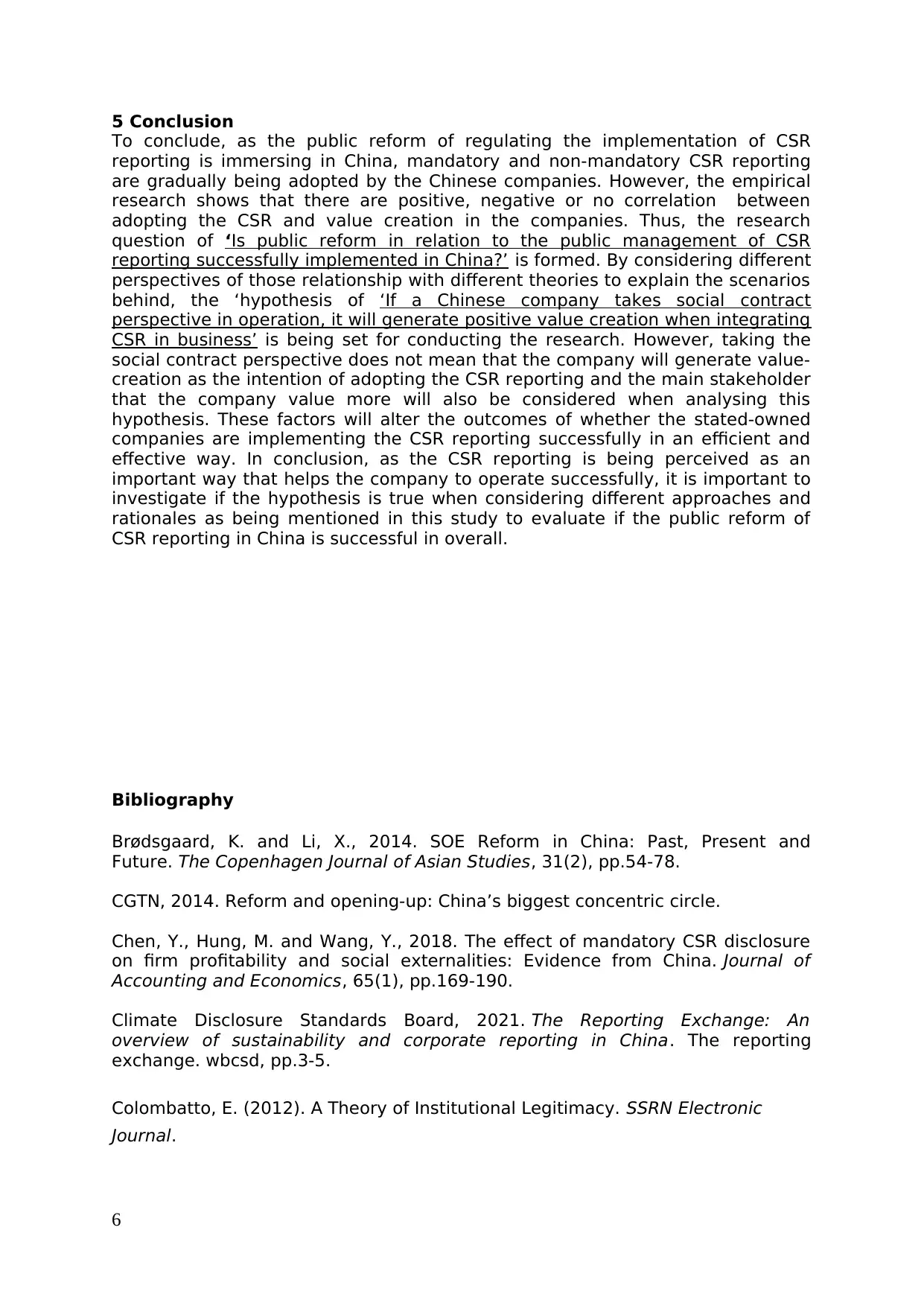
5 Conclusion
To conclude, as the public reform of regulating the implementation of CSR
reporting is immersing in China, mandatory and non-mandatory CSR reporting
are gradually being adopted by the Chinese companies. However, the empirical
research shows that there are positive, negative or no correlation between
adopting the CSR and value creation in the companies. Thus, the research
question of ‘Is public reform in relation to the public management of CSR
reporting successfully implemented in China?’ is formed. By considering different
perspectives of those relationship with different theories to explain the scenarios
behind, the ‘hypothesis of ‘If a Chinese company takes social contract
perspective in operation, it will generate positive value creation when integrating
CSR in business’ is being set for conducting the research. However, taking the
social contract perspective does not mean that the company will generate value-
creation as the intention of adopting the CSR reporting and the main stakeholder
that the company value more will also be considered when analysing this
hypothesis. These factors will alter the outcomes of whether the stated-owned
companies are implementing the CSR reporting successfully in an efficient and
effective way. In conclusion, as the CSR reporting is being perceived as an
important way that helps the company to operate successfully, it is important to
investigate if the hypothesis is true when considering different approaches and
rationales as being mentioned in this study to evaluate if the public reform of
CSR reporting in China is successful in overall.
Bibliography
Brødsgaard, K. and Li, X., 2014. SOE Reform in China: Past, Present and
Future. The Copenhagen Journal of Asian Studies, 31(2), pp.54-78.
CGTN, 2014. Reform and opening-up: China’s biggest concentric circle.
Chen, Y., Hung, M. and Wang, Y., 2018. The effect of mandatory CSR disclosure
on firm profitability and social externalities: Evidence from China. Journal of
Accounting and Economics, 65(1), pp.169-190.
Climate Disclosure Standards Board, 2021. The Reporting Exchange: An
overview of sustainability and corporate reporting in China. The reporting
exchange. wbcsd, pp.3-5.
Colombatto, E. (2012). A Theory of Institutional Legitimacy. SSRN Electronic
Journal.
6
To conclude, as the public reform of regulating the implementation of CSR
reporting is immersing in China, mandatory and non-mandatory CSR reporting
are gradually being adopted by the Chinese companies. However, the empirical
research shows that there are positive, negative or no correlation between
adopting the CSR and value creation in the companies. Thus, the research
question of ‘Is public reform in relation to the public management of CSR
reporting successfully implemented in China?’ is formed. By considering different
perspectives of those relationship with different theories to explain the scenarios
behind, the ‘hypothesis of ‘If a Chinese company takes social contract
perspective in operation, it will generate positive value creation when integrating
CSR in business’ is being set for conducting the research. However, taking the
social contract perspective does not mean that the company will generate value-
creation as the intention of adopting the CSR reporting and the main stakeholder
that the company value more will also be considered when analysing this
hypothesis. These factors will alter the outcomes of whether the stated-owned
companies are implementing the CSR reporting successfully in an efficient and
effective way. In conclusion, as the CSR reporting is being perceived as an
important way that helps the company to operate successfully, it is important to
investigate if the hypothesis is true when considering different approaches and
rationales as being mentioned in this study to evaluate if the public reform of
CSR reporting in China is successful in overall.
Bibliography
Brødsgaard, K. and Li, X., 2014. SOE Reform in China: Past, Present and
Future. The Copenhagen Journal of Asian Studies, 31(2), pp.54-78.
CGTN, 2014. Reform and opening-up: China’s biggest concentric circle.
Chen, Y., Hung, M. and Wang, Y., 2018. The effect of mandatory CSR disclosure
on firm profitability and social externalities: Evidence from China. Journal of
Accounting and Economics, 65(1), pp.169-190.
Climate Disclosure Standards Board, 2021. The Reporting Exchange: An
overview of sustainability and corporate reporting in China. The reporting
exchange. wbcsd, pp.3-5.
Colombatto, E. (2012). A Theory of Institutional Legitimacy. SSRN Electronic
Journal.
6
⊘ This is a preview!⊘
Do you want full access?
Subscribe today to unlock all pages.

Trusted by 1+ million students worldwide
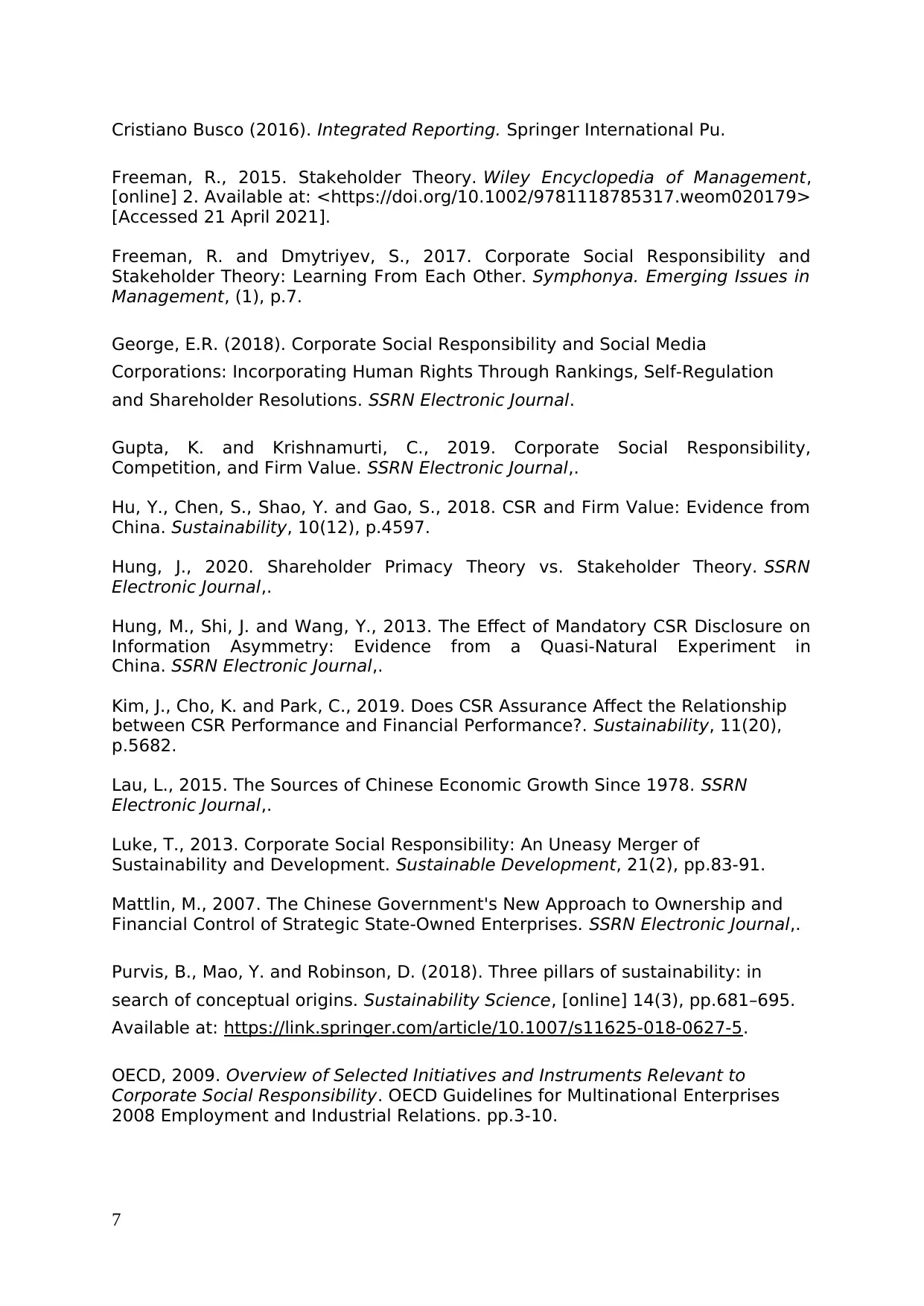
Cristiano Busco (2016). Integrated Reporting. Springer International Pu.
Freeman, R., 2015. Stakeholder Theory. Wiley Encyclopedia of Management,
[online] 2. Available at: <https://doi.org/10.1002/9781118785317.weom020179>
[Accessed 21 April 2021].
Freeman, R. and Dmytriyev, S., 2017. Corporate Social Responsibility and
Stakeholder Theory: Learning From Each Other. Symphonya. Emerging Issues in
Management, (1), p.7.
George, E.R. (2018). Corporate Social Responsibility and Social Media
Corporations: Incorporating Human Rights Through Rankings, Self-Regulation
and Shareholder Resolutions. SSRN Electronic Journal.
Gupta, K. and Krishnamurti, C., 2019. Corporate Social Responsibility,
Competition, and Firm Value. SSRN Electronic Journal,.
Hu, Y., Chen, S., Shao, Y. and Gao, S., 2018. CSR and Firm Value: Evidence from
China. Sustainability, 10(12), p.4597.
Hung, J., 2020. Shareholder Primacy Theory vs. Stakeholder Theory. SSRN
Electronic Journal,.
Hung, M., Shi, J. and Wang, Y., 2013. The Effect of Mandatory CSR Disclosure on
Information Asymmetry: Evidence from a Quasi-Natural Experiment in
China. SSRN Electronic Journal,.
Kim, J., Cho, K. and Park, C., 2019. Does CSR Assurance Affect the Relationship
between CSR Performance and Financial Performance?. Sustainability, 11(20),
p.5682.
Lau, L., 2015. The Sources of Chinese Economic Growth Since 1978. SSRN
Electronic Journal,.
Luke, T., 2013. Corporate Social Responsibility: An Uneasy Merger of
Sustainability and Development. Sustainable Development, 21(2), pp.83-91.
Mattlin, M., 2007. The Chinese Government's New Approach to Ownership and
Financial Control of Strategic State-Owned Enterprises. SSRN Electronic Journal,.
Purvis, B., Mao, Y. and Robinson, D. (2018). Three pillars of sustainability: in
search of conceptual origins. Sustainability Science, [online] 14(3), pp.681–695.
Available at: https://link.springer.com/article/10.1007/s11625-018-0627-5.
OECD, 2009. Overview of Selected Initiatives and Instruments Relevant to
Corporate Social Responsibility. OECD Guidelines for Multinational Enterprises
2008 Employment and Industrial Relations. pp.3-10.
7
Freeman, R., 2015. Stakeholder Theory. Wiley Encyclopedia of Management,
[online] 2. Available at: <https://doi.org/10.1002/9781118785317.weom020179>
[Accessed 21 April 2021].
Freeman, R. and Dmytriyev, S., 2017. Corporate Social Responsibility and
Stakeholder Theory: Learning From Each Other. Symphonya. Emerging Issues in
Management, (1), p.7.
George, E.R. (2018). Corporate Social Responsibility and Social Media
Corporations: Incorporating Human Rights Through Rankings, Self-Regulation
and Shareholder Resolutions. SSRN Electronic Journal.
Gupta, K. and Krishnamurti, C., 2019. Corporate Social Responsibility,
Competition, and Firm Value. SSRN Electronic Journal,.
Hu, Y., Chen, S., Shao, Y. and Gao, S., 2018. CSR and Firm Value: Evidence from
China. Sustainability, 10(12), p.4597.
Hung, J., 2020. Shareholder Primacy Theory vs. Stakeholder Theory. SSRN
Electronic Journal,.
Hung, M., Shi, J. and Wang, Y., 2013. The Effect of Mandatory CSR Disclosure on
Information Asymmetry: Evidence from a Quasi-Natural Experiment in
China. SSRN Electronic Journal,.
Kim, J., Cho, K. and Park, C., 2019. Does CSR Assurance Affect the Relationship
between CSR Performance and Financial Performance?. Sustainability, 11(20),
p.5682.
Lau, L., 2015. The Sources of Chinese Economic Growth Since 1978. SSRN
Electronic Journal,.
Luke, T., 2013. Corporate Social Responsibility: An Uneasy Merger of
Sustainability and Development. Sustainable Development, 21(2), pp.83-91.
Mattlin, M., 2007. The Chinese Government's New Approach to Ownership and
Financial Control of Strategic State-Owned Enterprises. SSRN Electronic Journal,.
Purvis, B., Mao, Y. and Robinson, D. (2018). Three pillars of sustainability: in
search of conceptual origins. Sustainability Science, [online] 14(3), pp.681–695.
Available at: https://link.springer.com/article/10.1007/s11625-018-0627-5.
OECD, 2009. Overview of Selected Initiatives and Instruments Relevant to
Corporate Social Responsibility. OECD Guidelines for Multinational Enterprises
2008 Employment and Industrial Relations. pp.3-10.
7
Paraphrase This Document
Need a fresh take? Get an instant paraphrase of this document with our AI Paraphraser
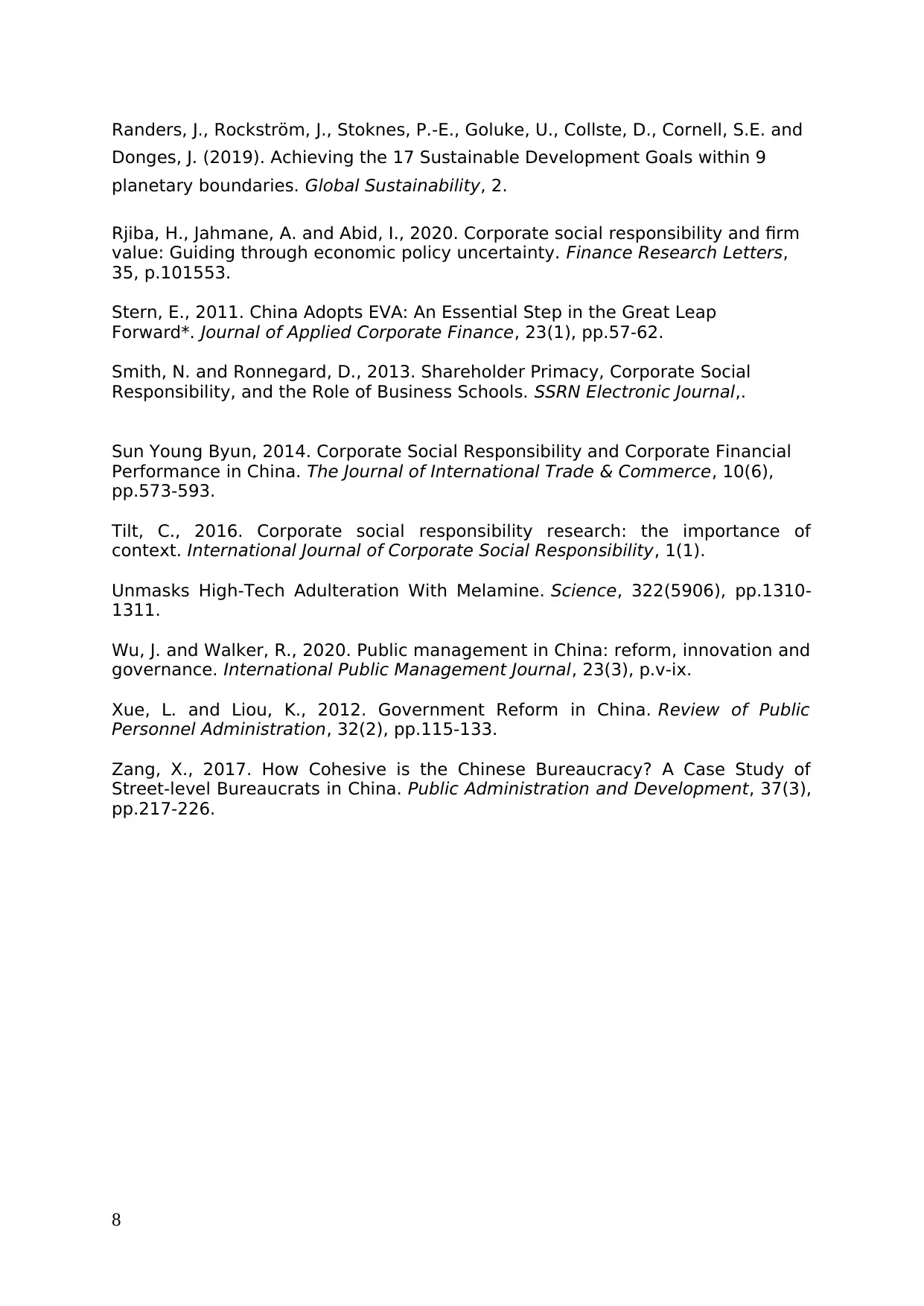
Randers, J., Rockström, J., Stoknes, P.-E., Goluke, U., Collste, D., Cornell, S.E. and
Donges, J. (2019). Achieving the 17 Sustainable Development Goals within 9
planetary boundaries. Global Sustainability, 2.
Rjiba, H., Jahmane, A. and Abid, I., 2020. Corporate social responsibility and firm
value: Guiding through economic policy uncertainty. Finance Research Letters,
35, p.101553.
Stern, E., 2011. China Adopts EVA: An Essential Step in the Great Leap
Forward*. Journal of Applied Corporate Finance, 23(1), pp.57-62.
Smith, N. and Ronnegard, D., 2013. Shareholder Primacy, Corporate Social
Responsibility, and the Role of Business Schools. SSRN Electronic Journal,.
Sun Young Byun, 2014. Corporate Social Responsibility and Corporate Financial
Performance in China. The Journal of International Trade & Commerce, 10(6),
pp.573-593.
Tilt, C., 2016. Corporate social responsibility research: the importance of
context. International Journal of Corporate Social Responsibility, 1(1).
Unmasks High-Tech Adulteration With Melamine. Science, 322(5906), pp.1310-
1311.
Wu, J. and Walker, R., 2020. Public management in China: reform, innovation and
governance. International Public Management Journal, 23(3), p.v-ix.
Xue, L. and Liou, K., 2012. Government Reform in China. Review of Public
Personnel Administration, 32(2), pp.115-133.
Zang, X., 2017. How Cohesive is the Chinese Bureaucracy? A Case Study of
Street-level Bureaucrats in China. Public Administration and Development, 37(3),
pp.217-226.
8
Donges, J. (2019). Achieving the 17 Sustainable Development Goals within 9
planetary boundaries. Global Sustainability, 2.
Rjiba, H., Jahmane, A. and Abid, I., 2020. Corporate social responsibility and firm
value: Guiding through economic policy uncertainty. Finance Research Letters,
35, p.101553.
Stern, E., 2011. China Adopts EVA: An Essential Step in the Great Leap
Forward*. Journal of Applied Corporate Finance, 23(1), pp.57-62.
Smith, N. and Ronnegard, D., 2013. Shareholder Primacy, Corporate Social
Responsibility, and the Role of Business Schools. SSRN Electronic Journal,.
Sun Young Byun, 2014. Corporate Social Responsibility and Corporate Financial
Performance in China. The Journal of International Trade & Commerce, 10(6),
pp.573-593.
Tilt, C., 2016. Corporate social responsibility research: the importance of
context. International Journal of Corporate Social Responsibility, 1(1).
Unmasks High-Tech Adulteration With Melamine. Science, 322(5906), pp.1310-
1311.
Wu, J. and Walker, R., 2020. Public management in China: reform, innovation and
governance. International Public Management Journal, 23(3), p.v-ix.
Xue, L. and Liou, K., 2012. Government Reform in China. Review of Public
Personnel Administration, 32(2), pp.115-133.
Zang, X., 2017. How Cohesive is the Chinese Bureaucracy? A Case Study of
Street-level Bureaucrats in China. Public Administration and Development, 37(3),
pp.217-226.
8
1 out of 8
Related Documents
Your All-in-One AI-Powered Toolkit for Academic Success.
+13062052269
info@desklib.com
Available 24*7 on WhatsApp / Email
![[object Object]](/_next/static/media/star-bottom.7253800d.svg)
Unlock your academic potential
Copyright © 2020–2025 A2Z Services. All Rights Reserved. Developed and managed by ZUCOL.



